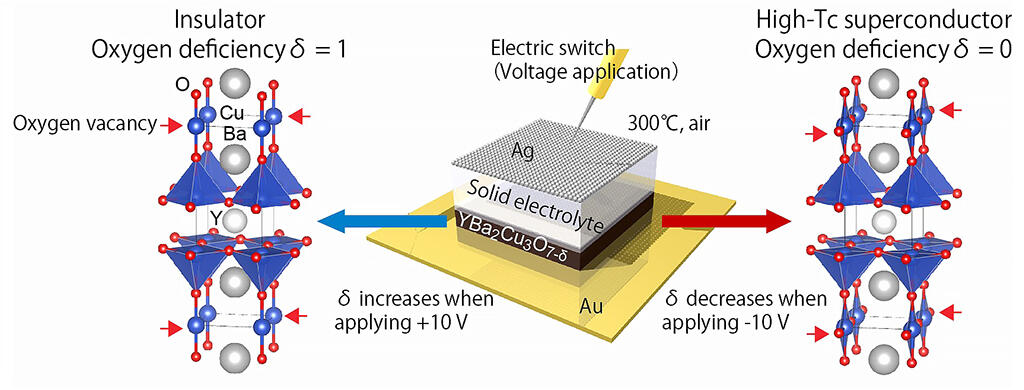A research group led by Postdoctoral Fellow Xi Zhang and Professor Hiromichi Ohta of the Research Institute for Electronic Science, Hokkaido University, has succeeded in the repeated switching of an insulator to a superconductor using a single electrical switch.
The conductivity of yttrium-barium-copper composite oxides (YBCO), known as high-temperature superconductors, varies considerably according to the oxygen content, i.e., from insulators to superconductors. Recently, a method for electrically adjusting the oxygen content was proposed as an approach for switching between an insulator and a superconductor. However, as an electrolyte solution is used, there exists an application problem in that the device must be appropriately sealed such that the liquid does not leak. Instead of an ionic liquid or an electrolyte, the study group employed yttria-stabilized zirconia (YSZ), which is a solid electrolyte, as a substrate, prepared an YBCO thin film on it, and altered the oxygen deficiency, δ, in the YBCO thin film electrochemically by heating it to 300 ℃ in air and applying a voltage across it. To convert the insulator into a superconductor, a voltage of -10 V was applied; by contrast, to turn the superconductor into an insulator, a voltage of +10 V was applied. The amount of oxygen deficiency, δ, was controlled by adjusting the retention time.

Credit: Hiromichi Ohta
As a result, δ could be varied from 0.069 to 0.87. It was found that the superconducting transition temperature, Tc, increases as δ decreases. By contrast, when δ was 0.64, 0.72, 0.86, and 0.87, superconducting transition did not occur; at δ = 0.87, it clearly exhibits the behavior of an insulator, where the electrical resistance increases with a decrease in temperature. Switching between the insulator and high‐Tc superconductor could be carried out repeatedly.
Prof. Ohta says, "The operating temperature is as high as 300 °C, but because of the ease of applying voltage in the air, we were able to succeed well. In the future, we would like to develop a solid electrolyte that operates at a lower temperature and reduce the device operation temperature to truly commercialize it. We have applied for a patent for the technology related to this research result."
This article has been translated by JST with permission from The Science News Ltd.(https://sci-news.co.jp/). Unauthorized reproduction of the article and photographs is prohibited.




